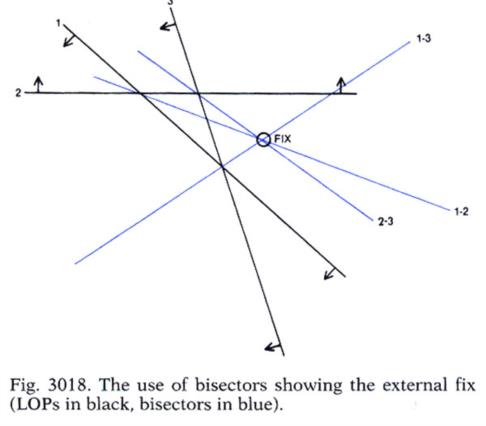
NavList:
A Community Devoted to the Preservation and Practice of Celestial Navigation and Other Methods of Traditional Wayfinding
Re: Position lines, crossing.
From: Bill B
Date: 2006 Dec 10, 19:10 -0500
From: Bill B
Date: 2006 Dec 10, 19:10 -0500
> George writes: > > List members will appreciate the difficulties we are faced with in > trying to convince others about the realities of a cocked hat. > Already, three have put their heads up in defence of their cherished > illusions; Peter Fogg, Bill, and Robert Eno. No doubt, others will > join them. We've seen it before. More like an argument out of a statement or two. I do not doubt George's 25% figure, I have just, as noted, never seen it before. While not a precise statistic, my intention was to agree with George, hence the statement term "hit or miss" based on not knowing if there were personal or systematic errors at the time. My belief at the time being that those potential problems, as well as using celestial objects with azimuths of 180d or less apart, could lead to the fix being external rather than internal (inside the cocked hat). George's scholarly and thorough explanation was most appreciated. Live and learn. Just to set the record straight, below is the only reference I have read. This is simply a statement, not a position or jumping off point for an argument.Opinions? Bill ========== LOP BISECTORS Dutton's Nautical Navigation 15th Edition 3018 When observations of a number of bodies with azimuths all lying within a horizontal 180d sector of arc are obtained, a constant error (in both magnitude and sign) may yield misleading results if the fix is assumed to lie within the polygon formed by the LOPs; such a fix is often called an "internal fix. Such constant errors could result from an uncorrected personal error or from unusual terrestrial refraction, which causes the value of the dip, as obtained from the Nautical Almanac, to be considerably in error. The correct fix may lie outside the polygon, resulting in an "external" fix rather than the usual internal one. Where multiple LOPs well distributed in azimuth are obtained, this problem does not arise, because in this case the error may be assumed to affect all LOPs about equally. Where three or more observations are made of bodies with azimuths within 180° of each other, it is useful to use LOP bisectors to determine the fix. Each angle formed by a pair of position lines is bisected, being drawn in the direction of the mean of the azimuths of the two bodies. For example, assume that because of cloud cover, only three stars could be observed, the respective azimuths being as follows: star No. 1, 224d; No. 2, 000d, and No. 3, 256d. The resulting LOPs are plotted in figure 3018. Note that arrows have been added to each LOP to show the direction of the celestial body; this practice is desirable for any celestial plot. LOPs 1 and 2 will be bisected in the direction 292d>- 112d: ((224 + 000)/2) = 112 LOPs 1 and 3 will be bisected in the direction 240d 060d: ((224d +256d)/2) = 240 and LOPs 2 and 3 will be bisected in the direction 308d 128d. In figure 3018 these bisectors are drawn in as blue lines. The most probable position for the fix lies at the center of any small triangle formed by the three bisectors, rather than in the triangle formed by the three LOPs. Note that this external fix shows an apparent greater "error" (distance from the three LOPs) than is shown by assuming the center of the original triangle, but this disparity is misleading. It can be seen in figure 3018 that the external fix is a point equidistant from each LOP in the same direction, "away" in this example. Such a point can also be estimated by eye, taking care to always be on the same side of each LOP as indicated by the arrows. This technique is more practical at sea than calculating the bisector directions and cluttering up the plot with several additional lines; it should be sufficiently accurate for practical navigation. The "external" fix should be found and used only when there is good reason to believe that there is an error in each observation of constant magnitude and direction. Barring this condition, the navigator is safer to use the internal fix. --~--~---------~--~----~------------~-------~--~----~ To post to this group, send email to NavList@fer3.com To , send email to NavList-@fer3.com -~----------~----~----~----~------~----~------~--~---







